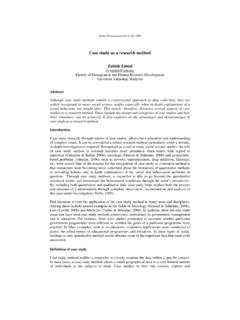Transcription of Case Study of Successful Complex IT Projects - bcs.org
1 THE BRITISH COMPUTER SOCIETY case Study of Successful Complex IT Projects AUGUST 2006 case Study of Successful , Complex IT Projects Table of Contents Executive Background to the The complexity of IT Part I: Research Part II: case eCourier company eCourier industry eCourier technological LogicaCMG company LogicaCMG industry LogicaCMG technological Complexity of the two Similarities and differences between the two Part III: Critical Success Part IV: 1. Change The significance of change Existing 2. Stakeholder The significance of stakeholder Identifying key Managing the Managing Managing across External Managing staff and 3. Risk The sources of Risk management 4. Communications The significance of communications Communication for change Communication for stakeholder Communication for risk Part V Recommendations and Building a well structured Defining success criteria clearly with Understanding market Understanding and managing technical 1 case Study of Successful , Complex IT Projects Managing the project through the proposed control Appendix 1: Skill Mapping against the BCS SFIA plus Project Team Mapping to the SFIA plus Appendix 2: Project Control Appendix 3: List of 2 case Study of Successful , Complex IT Projects 1.
2 Executive Summary This case Study is a follow-up to the British Computer Society (BCS) Royal Academy of Engineering report The Challenges of Complex IT Projects , and the 2005 case Study of Successful Complex IT Projects developed by other Lancaster University students. This case Study has been produced by Lancaster University MSc E-Business and Innovation students for the BCS, focusing on two Successful , Complex , IT Projects , which won BCS Awards in 2005. One is LogicaCMG s Instant Energy project a company involved in designing, researching and producing a prepayment gas meter which would benefit both the energy suppliers and domestic customers. The other is the eCourier System project a company involved in the development of mobile devices, global positioning systems (GPS) and an easy-to-use online booking system to connect clients with couriers in the same-day delivery of parcels. The aims of this report are to explore what made these IT Projects Successful , form ideas about best practices regarding how to deal with complexity in IT Projects and the critical success factors that are involved in such IT Projects .
3 The two Projects were studied using secondary and primary data as real and on-going examples of Successful IT Projects . When looking at project success, project failure and its recognition and avoidance is an important part of success. An important contributor to failure is complexity, because it creates and potentially overwhelms a project with much uncertainty and risk. A complexity model is created in this report (See Figures 1&2), illustrating that the complexity in IT Projects is formed from macro-environmental, micro-environmental, organisational and project-related factors. The macro-environment requires a balance among political, economic, social, technological, environmental and legal factors (PESTEL). The micro-environment involves issues and people who control or influence the project, such as the client and other industry participants.
4 The organisational and the project environment are 3 case Study of Successful , Complex IT Projects internal factors that can help in either detecting, managing and addressing external factors which contribute to complexity. Influence, or in adding to project complexity. Each factor of complexity can influence the project in a different way and intensity. Successful Projects depend on a project manager who can act to manage the balance among these various factors. Based on secondary research, various project processes can ameliorate this complexity and increase success, and are thus critical success factors (CSFs) for IT Projects : market research, project planning, technical issues, change management, stakeholder management, risk management and communications management. To Study the critical success factors for the two specific Projects , secondary research and telephone and face-to-face interviews were conducted with LogicaCMG and eCourier.
5 Change management, stakeholder management, risk management and communications management were identified as the four most important categories of success factors. Findings are derived from the four areas. The project manager has to have the skills and knowledge to manage change, stakeholder relationships and risk, through effective communication. This Study identified five general recommendations for the IT project managers; 1. Building a well structured team 2. Defining success criteria clearly with stakeholders 3. Understanding market needs 4. Understanding and managing technical issues 5. Managing the project through the proposed project control cycle (See Appendix 2), which consists of planning, monitoring, reporting, decision making, corrective actions and revising stages. 4 case Study of Successful , Complex IT Projects 2. Introduction Background to the Study This report is produced for the BCS (British Computer Society) by Lancaster University students, studying for an MSc in E-Business and Innovation.
6 The team is composed of three students with complementary skills, and two supervisors from management science and computing science. This case Study aims to explore the critical success factors in Complex and Successful IT Projects . In addition, the sources of complexity in these Projects will be analyzed in order to understand how complexity is managed and reduced in order to achieve project success. To do so, we will gather relevant concepts and categories from various literatures, and compare and contrast this with two cases of Successful IT Projects , in order to produce general recommendations for managing complexity in IT Projects . The two cases, LogicaCMG and eCourier, were identified by the BCS as Complex and Successful Projects , and thus serve as best-practice examples. The sources of complexity in IT Projects will be discussed in the introduction section. Research methodology and research questions are outlined in part I.
7 Part II of the report describes the two cases, including the company and industry backgrounds. Sources of complexity in these two specific cases will be analyzed, as well as the similarities and differences between them. Part III discusses the general critical success factors for IT Projects , based on secondary research. The findings from the two cases are discussed in part IV, which includes four main topics which address complexity: change management, stakeholder management, risk management and communications management. Lastly, general recommendations for IT Projects are provided, based on the research results. 5 case Study of Successful , Complex IT Projects The complexity of IT Projects According to research from the Royal Academy of Engineering and the British Computer Society (2004), only 16% of IT Projects are considered truly Successful . Studying the factors and processes that contribute to complexity on IT Projects and their management is important in understanding why IT Projects fail, and how the management of complexity increases the chances of success.
8 While an important source of complexity in IT Projects is technology, the key source of complexity is the scope of the project set by management, the various social, economic and technical factors that then influence the success or failure in meeting the project objectives, and the various social and technical strategies employed by the project team to detect and manage these internal and external influences. The external sources that need to be detected and considered in the IT project are depicted in Figure 1. The sources of complexity for an IT project are based in the project environment. Many social, political and economic issues in both the project s internal and external environment, in addition to technology, need to be considered. Figure 1 complexity model 6 case Study of Successful , Complex IT Projects An IT project is conceived and conducted within a large and uncertain environment, which can produce considerable complexity for the project planners and participants when the relationships among these various factors are numerous, interactive, unknown, unpredictable and ambiguous.
9 In various environments, different issues contribute to the complexity of the project, but even in the same environment, particular project goals and outcomes will be affected by numerous and interacting factors. It is the anticipation, detection, evaluation and consideration of what role these factors play in the success and failure of the project that increases project success. The sources of these environmental influences are to be considered next, using the PESTEL framework: political, economical, social, technological, environmental and legal. z Macro-environment For different IT Projects , the ranking of importance for the five issues in the macro-environment differ (political, economical, social, technical, environmental, and legal). Considering the macro-environment around an IT project, the technical issues bring a large source of uncertainty and complexity to the project.
10 An important part of this complexity is the pace of change in the technical environment which can quickly render current business and technical plans obsolete, as new technologies present ever-changing social and business possibilities. z Micro-environment Clients of IT Projects are included in the micro-environment. As a source of complexity, determining a stable set of client requirements is an important issue. Due to the Complex technical issues that may be present in the project, the clients may not fully understand what they want. Their requirements may be unrealistic, unachievable, and often change, because of the uncertain technical issues or capabilities, as well as an uncertain business environment and an infinite number of business possibilities that could arise from a given technical system. Developing, constricting, understanding and communicating such requirements is a challenge for the whole 7 case Study of Successful , Complex IT Projects project team, especially in setting a reasonable project scope with the user s input, and deciding where and how particular users will be involved in the setting of the scope and system requirements.







